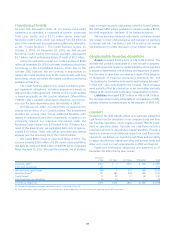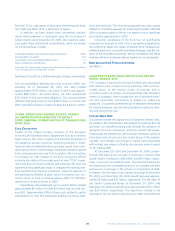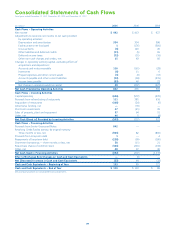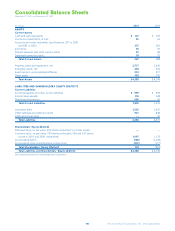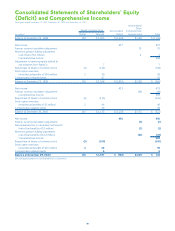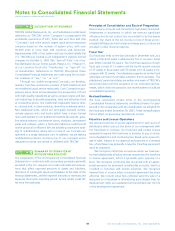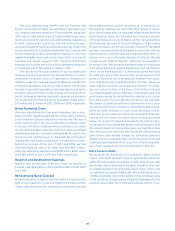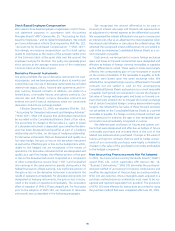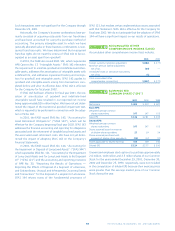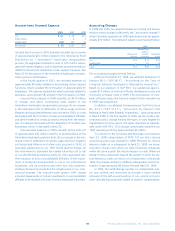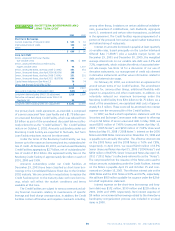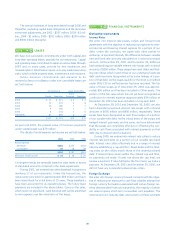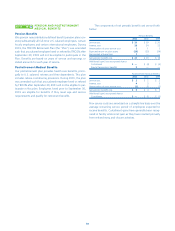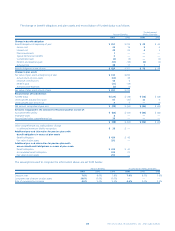Pizza Hut 2001 Annual Report Download - page 46
Download and view the complete annual report
Please find page 46 of the 2001 Pizza Hut annual report below. You can navigate through the pages in the report by either clicking on the pages listed below, or by using the keyword search tool below to find specific information within the annual report.44 TRICON GLOBAL RESTAURANTS, INC. AND SUBSIDIARIES
Considerable management judgment is necessary to esti-
mate future cash flows, including sublease income. Accordingly,
actual results could vary significantly from the estimates.
Impairment of Long-Lived Assets
We review our long-lived assets related to each restaurant to be
held and used in the business, including any allocated intangi-
ble assets, semi-annually for impairment, or whenever events or
changes in circumstances indicate that the carrying amount of
a restaurant may not be recoverable. We evaluate restaurants
using a “two-year history of operating losses” as our primary
indicator of potential impairment. Based on the best informa-
tion available, we write down an impaired restaurant to its
estimated fair market value, which becomes its new cost basis.
We generally measure estimated fair market value by discount-
ing estimated future cash flows. In addition, when we decide to
close a store beyond the quarter in which the closure decision
is made, it is reviewed for impairment and depreciable lives are
adjusted. The impairment evaluation is based on the estimated
cash flows from continuing use until the expected disposal date
plus the expected terminal value.
Considerable management judgment is necessary to esti-
mate future cash flows. Accordingly, actual results could vary
significantly from our estimates.
Impairment of Investments in Unconsolidated
Affiliates and Enterprise-level Goodwill
Our methodology for determining and measuring impairment
of our investments in unconsolidated affiliates and enterprise-
level goodwill is similar to the methodology we use for our
restaurants except: (a) the recognition test for an investment in
an unconsolidated affiliate compares the carrying amount of our
investment to a forecast of our share of the unconsolidated affil-
iate’s undiscounted cash flows after interest and taxes instead
of undiscounted cash flows before interest and taxes used for
our restaurants; and (b) enterprise-level goodwill is generally
evaluated at a country level instead of by individual restaurant.
Also, we record impairment charges related to investments in
unconsolidated affiliates whenever other circumstances indicate
that a decrease in the value of an investment has occurred
which is other than temporary.
Considerable management judgment is necessary to esti-
mate future cash flows. Accordingly, actual results could vary
significantly from our estimates.
Cash and Cash Equivalents
Cash equivalents represent funds we have temporarily invested
(with original maturities not exceeding three months) as part
of managing our day-to-day operating cash receipts and
disbursements.
Inventories
We value our inventories at the lower of cost (computed on the
first-in, first-out method) or net realizable value.
Property, Plant and Equipment
We state property, plant and equipment at cost less accumu-
lated depreciation and amortization, impairment writedowns
and valuation allowances. We calculate depreciation and amor-
tization on a straight-line basis over the estimated useful lives
of the assets as follows: 5 to 25 years for buildings and improve-
ments, 3 to 20 years for machinery and equipment and 3 to 7
years for capitalized software costs. As discussed further above,
we suspend depreciation and amortization on assets related to
restaurants that are held for disposal.
Internal Development Costs and Abandoned
Site Costs
We capitalize direct costs associated with the site acquisition
and construction of a Company unit on that site, including direct
internal payroll and payroll-related costs and direct external
costs. Only those site-specific costs incurred subsequent to the
time that the site acquisition is considered probable are capital-
ized. We consider acquisition probable upon final site approval.
If we subsequently make a determination that a site for which
internal development costs have been capitalized will not be
acquired or developed, any previously capitalized internal devel-
opment costs are expensed and included in general and
administrative expenses.
Intangible Assets
Intangible assets include both identifiable intangibles and good-
will arising from the allocation of purchase prices of businesses
acquired. Where appropriate, intangible assets are allocated to
individual restaurants at the time of acquisition. We base
amounts assigned to identifiable intangibles on independent
appraisals or internal estimates. Goodwill represents the resid-
ual purchase price after allocation to all identifiable net assets.
Our intangible assets are stated at historical allocated cost less
accumulated amortization and impairment writedowns. We
amortize intangible assets on a straight-line basis as follows: up
to 20 years for reacquired franchise rights, 3 to 40 years for
trademarks and other identifiable intangibles and up to 20 years
for goodwill. As discussed above, we suspend amortization on
intangible assets allocated to restaurants that are held for disposal.
See “New Accounting Pronouncements Not Yet Adopted”
for a discussion of the anticipated impact of Statement of
Financial Accounting Standards (“SFAS”) No. 141, “Business
Combinations” (“SFAS 141”) and SFAS No. 142, “Goodwill and
Other Intangible Assets” (“SFAS 142”) on our accounting for
intangible assets.



